Valley of many cellars
Valpolicella with potential
2 April 2024
Werner Elflein
 Photo: weinfreaks.de
Photo: weinfreaks.deThe Valpolicella area (Latin vallis poli cellae, valley of many cellars) lies east of Lake Garda and north of Verona in the Italian region of Veneto. It is geographically divided into three zones: Valpolicella Classico, Valpolicella Valpantena and Valpolicella Orientale. Only red wines are produced, which are often rather light-bodied and are drunk young. However, the top wines have much more potential and can mature gracefully. A selection of wines presented by the Consorzio tutela dei vini della Valpolicella in the run-up to this year's ProWein international wine fair during a lunch at the Rossini restaurant in Düsseldorf emphasised the fact that they also make excellent accompaniments to food.
The 2019 Valpolicella Ripasso Classico Superiore Campedel from the three brothers Giovanni, Giuseppe and Martino Aldrighetti, who founded the Azienda Agricola Gamba in 2003, was served as an aperitif. The family cultivates 15 hectares of terraced vineyards in Valpolicella Classico at an altitude of 300 metres above sea level. The grapes for the Ripasso come partly from double pergolas and partly from Guyot vineyards. Ripasso means repetition or second passage. For this, the finished red wine is added to the pomace of an Amarone and achieves a higher concentration through a second fermentation set in motion by sugar and yeast residues contained in the berry skins of the pomace. Despite its rich cherry and plum flavours, the Ripasso Campedel is anything but ponderous or overloaded. A successful start.
 Photo: weinfreaks.de
Photo: weinfreaks.deThe first course of the menu, tuna cheeks in a puffed potato coating with smoked oyster and lemon angel, was accompanied by the 2021 Valpolicella Classico from Monte Castelon. The Tommasi family winery is committed to organic viticulture and cultivates vineyards at an altitude of between 400 and 530 metres. The Valpolicella Classico comes from a vineyard planted in the so-called Pergola Veronese system: vertical poles support a slightly sloping roof structure, over which iron wires are passed to help the vines grow. Despite its good concentration, it has a surprisingly moderate alcohol content of only 12 %.
This was followed by Riso Vialone Nano Veronese in three layers of Parmigiano Regginao with Valpolicella jelly and the 2020 “Campo selce” Valpolicello Superiore from Contrada Palui. Hans Karl Pichler, who comes from South Tyrol, works organically both in the vineyard and in the cellar. His vineyards above Verona, which lie between 500 and 540 metres above sea level, are characterised by limestone, basalt and flint. As the name of the wine suggests, the “Campo selce” comes from a vineyard that is particularly rich in flint. Pichler ages the wine in medium-toasted French oak tonneaux and handmade clay amphorae.
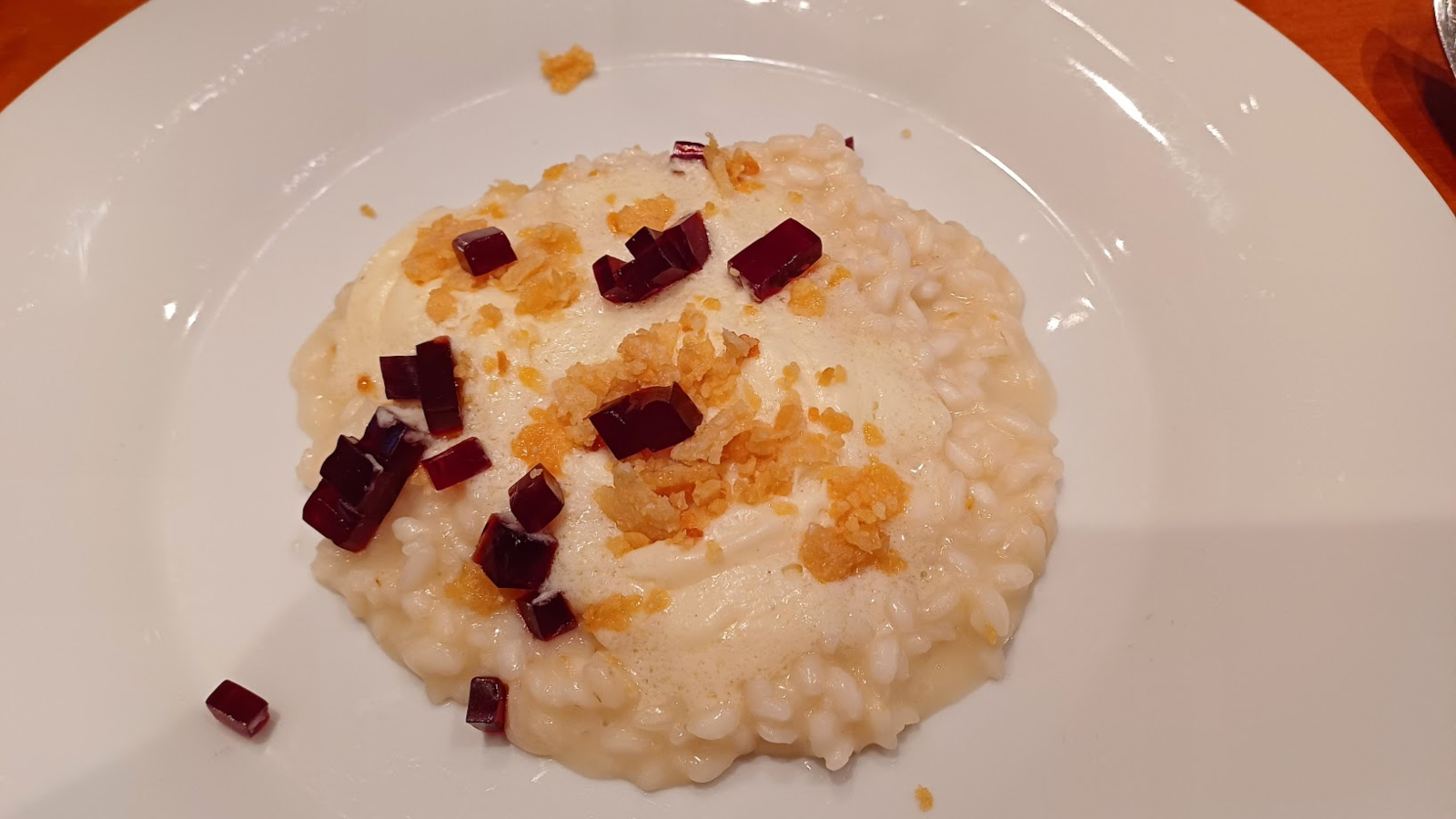 Photo: weinfreaks.de
Photo: weinfreaks.deFor the next course, cod cooked in olive oil with fermented black garlic, caviar sauce and salicornia seaweed, the wine of choice was the 2021 Valpolicella Superiore from Lavagnoli. It was not until 2015 that the Lavagnolis decided to process the grapes from their vineyards into wine themselves. The family chose the great spotted woodpecker as a symbol, from which the village of Pigozzo (“Pigosso” stands for the woodpecker in the Veronese dialect) takes its name. Only the ripest and healthiest grapes are selected for the Valpolicella Superiore and lightly dried for 10 to 14 days before pressing. The wine is aged for 12 months in third-used French tonneaux. The production is limited to around 2400 bottles.
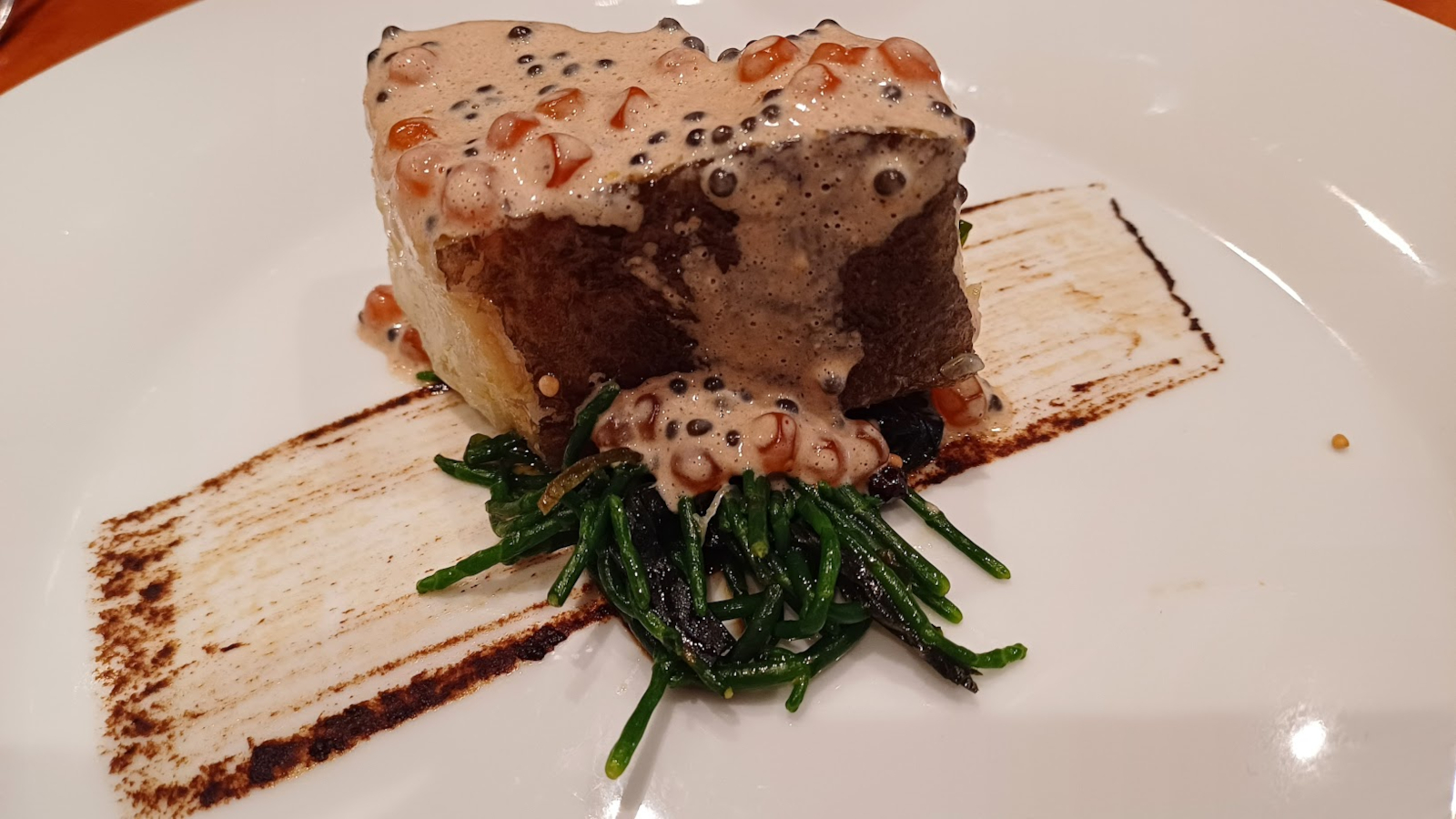 Photo: weinfreaks.de
Photo: weinfreaks.deThe 2019 “Montegradella” Valpolicella Classico Superiore from Santa Sofia was at its best with three-course royal quail, Valpolicella Ripasso reduction sauce with spring truffles, olive oil and chervil emulsion, potato mousse with Asiago. The winery looks back on a tradition dating back to 1811 and, with around 70 hectares of vineyards, is one of the large producers in Valpolicella. Part of the annual production comes from grape purchases. The “Montegradella” is traditionally matured in oak barrels, where it remains for around 18 months until bottling. Despite its full body with aromas of prune and cherry, it cannot deny a certain elegance. Its high-quality tannins suggest that it will mature favourably over several years. The 2019 is now approaching its peak, but should remain at its high level for another five years.
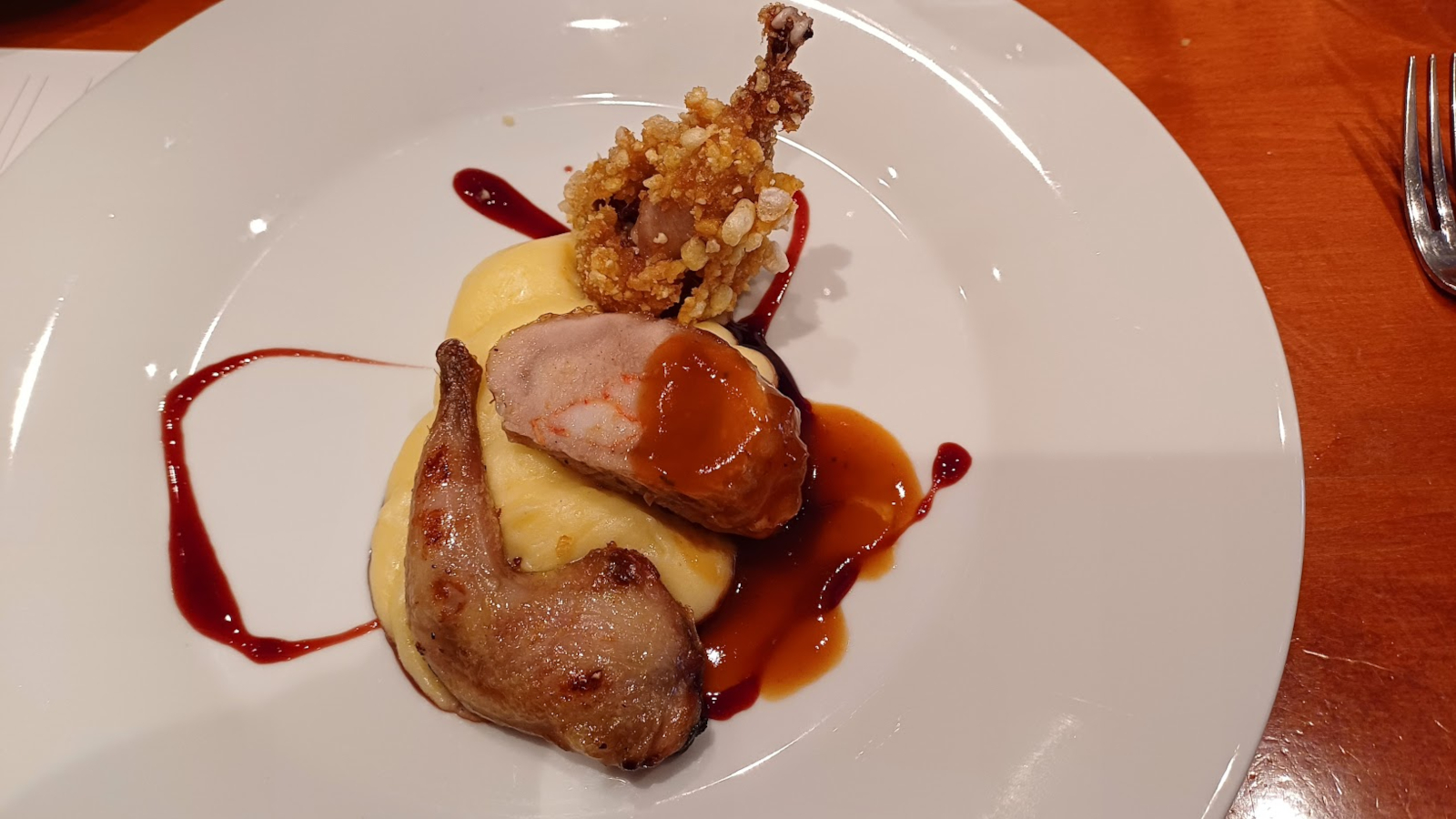 Photo: weinfreaks.de
Photo: weinfreaks.deAs a pre-dessert, Asiago cheese in various degrees of ripeness with Amarone and onion marmalade was paired with a 2015 Amarone della Valpolicella Classico from Secondo Marco. For an Amarone, ripe grapes are dried for at least 100 days. During this process, the grapes lose between a third and half of their weight. The alcohol content of the matured red wines is correspondingly high. The drying of the grapes can give an Amarone a slightly sweet flavour. However, it is basically dry. In the past, the volatile acidity of Amarone, which was feared as a wine defect, was still part of good taste, but the style of the wines has changed significantly in recent years. Thanks to the processing of ripe (and no longer overripe) grapes, modern Amarone wines, including Secondo Marco's, are no longer rustic and ponderous, but show complexity.
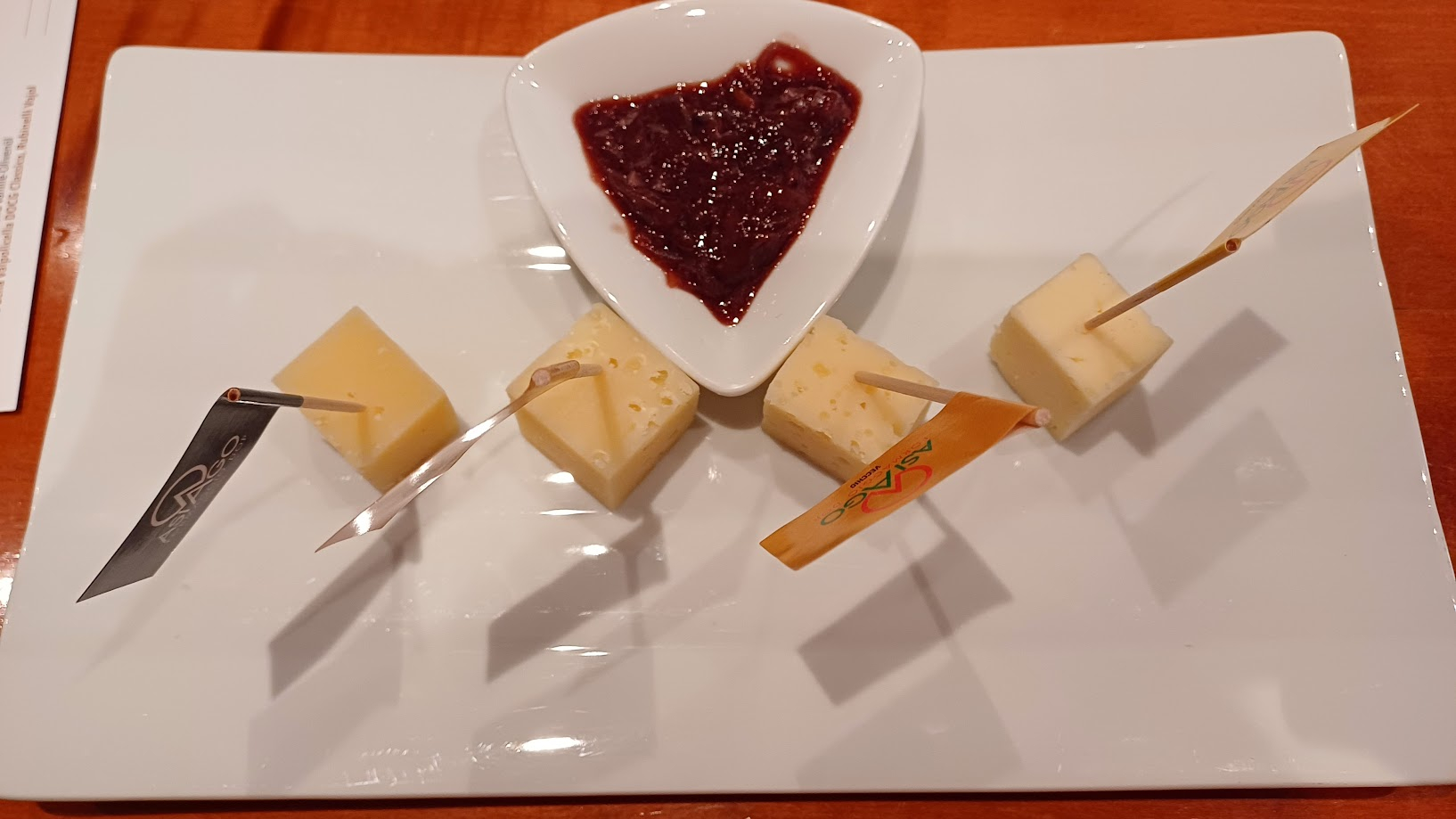 Photo: weinfreaks.de
Photo: weinfreaks.deSimilar to Amarone, the grapes for Recioto are also dried. The production process is the same as for straw wine. The grapes must remain in a special drying facility for at least 120 days. In contrast to Amarone, Recioto is a sweet wine that can be a suitable accompaniment to desserts. The 2016 Recioto della Valpolicella from Rubinelli Vajol went very well with peanut parfait with cocoa crumble and vanilla olive oil.
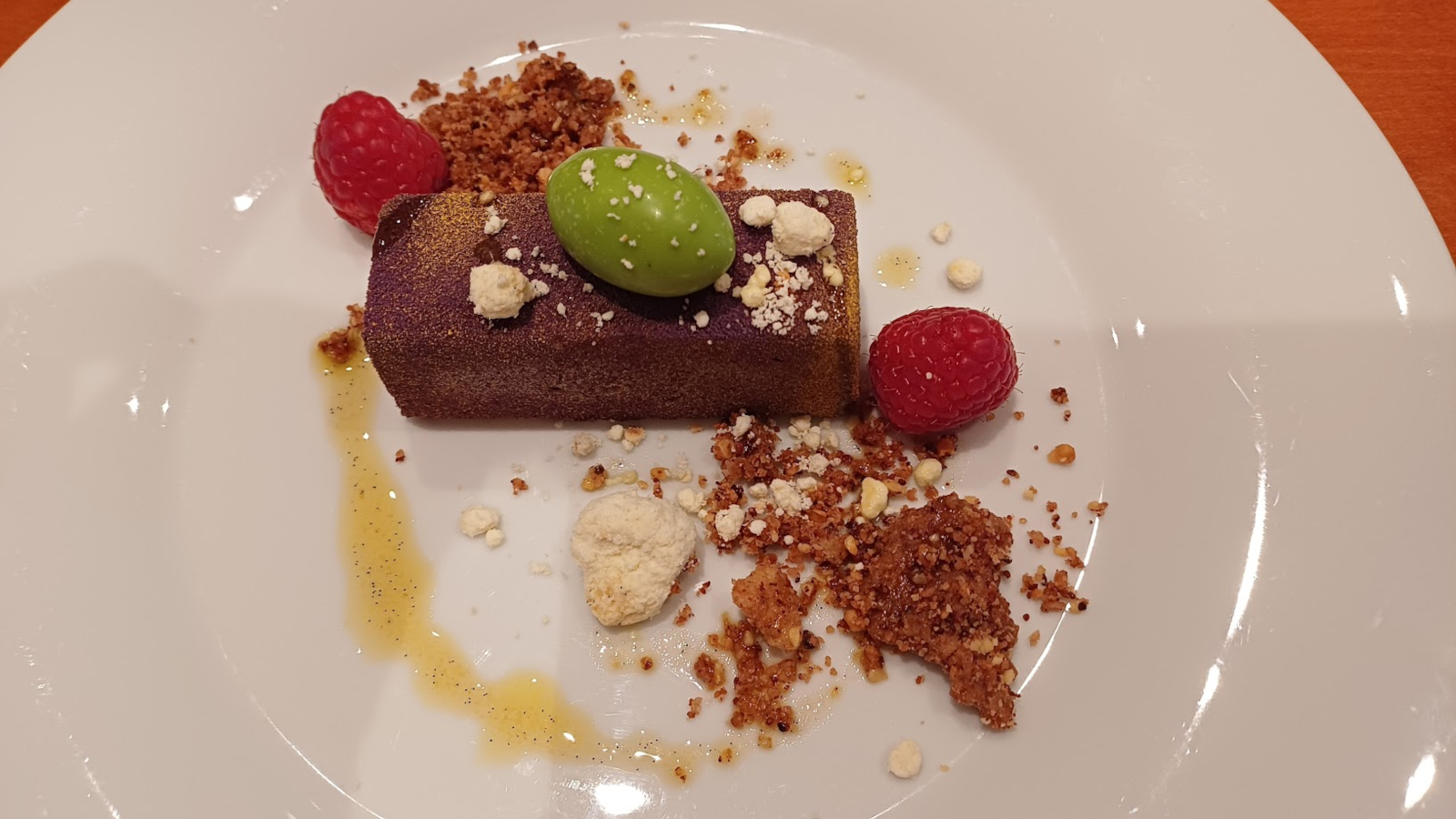 Photo: weinfreaks.de
Photo: weinfreaks.deThe grape varieties of Valpolicella
Red wines from Valpolicella must contain the grape varieties Corvina Veronese (at least 45 %) and Rondinella (at least 5 %). However, the proportion of Rondinella may not exceed 30 %. Corvina Veronese can be replaced up to 50 % by Corvinone Veronese, which was previously thought to be identical to Corvina Veronese. However, genetic analyses have shown that the two grape varieties are only distantly related. The proportion of the other authorised grape varieties Sangiovese, Cabernet Franc, Molinara, Negrara, Croatina and Oseleta may not exceed 25 %.
Corvina Veronese is the most important grape variety in Valpolicella. As the wines from this variety have an unharmonious flavour, blending with at least Rondinella is mandatory. Rondinella originates from a cross between Corvina Veronese and an unknown vine. Like Corvina Veronese and Rondinella, Corvinone Veronese is late-ripening, but has a higher yield and is considered to be of lower quality.
The wines at a glance
Symbols
| ⧛ | The rating of the wine reflects the mean value from a tasting by our jury. |
| ⚖ | The wine was evaluated in a blind tasting. |
| ⛬ | The wine was tasted as a barrel sample or before an official test number (Amtliche Prüfungsnummer or Staatliche Prüfnummer) was issued. |
| ▲ | The wine exhibited a sensory abnormality during our tasting. This does not necessarily have to be a qualitative defect or a wine fault. In the case of a qualitative impairment, a devaluation or rejection was made depending on the type and severity of the defect or wine fault. |
Contrada Palui
Via Caiò
37141 Verona
Italy
Phone: +39 349 2139518
Internet: www.contradapalui.com
E‑mail: hkp@contradapalui.com
WinereddryCorvina VeroneseCorvinone VeroneseRondinella
2020 Valpolicella Superiore “Campo selce”
Italy
Veneto ↳ Valpolicella • Denominazione di origine controllata (DOC)
13.5 % alcohol
Gamba
Via Gnirega, 19
37020 Marano di Valpolicella
Italy
Phone: +39 045 6801714
Internet: www.vinigamba.it
E‑mail: info@vinigamba.it
WinereddryCorvina VeroneseCorvinone VeroneseOseletaRondinella
2019 Valpolicella Ripasso Classico Superiore Campedel
Italy
Veneto ↳ Valpolicella Ripasso Classico • Denominazione di origine controllata (DOC)
13.5 % alcohol
Lavagnoli
Via Squaranto, 29c
37141 Verona
Italy
Phone: +39 349 2801553
Internet: www.cantinalavagnoli.it
E‑mail: info@cantinalavagnoli.it
WinereddryCorvina VeroneseCorvinone VeroneseMolinaraRondinella
2021 Valpolicella Superiore
Italy
Veneto ↳ Valpolicella • Denominazione di origine controllata (DOC)
14 % alcohol
Monte Castelon
Via Caio Mario, 9
37020 San Rocco
Italy
Phone: +39 340 3876498
Internet: www.montecastelon.it
E‑mail: info@montecastelon.it
WinereddryCorvina VeroneseCorvinone VeroneseMolinaraRondinella
2021 Valpolicella Classico
Italy
Veneto ↳ Valpolicella Classico • Denominazione di origine controllata (DOC)
12 % alcohol
Rubinelli Vajol
Via Paladon, 31
37029 San Pietro in Cariano
Italy
Phone: +39 045 6839277
Internet: www.rubinellivajol.it
E‑mail: info@rubinellivajol.it
WineredsweetCorvina VeroneseCorvinone VeroneseMolinaraOseletaRondinella
2016 Recioto della Valpolicella Classico
Italy
Veneto ↳ Recioto della Valpolicella Classico • Denominazione di origine controllata e garantita (DOCG)
14.5 % alcohol
Santa Sofia
Via Ca' Dedè
37020 San Pietro in Cariano
Italy
Phone: +39 045 7701074
Internet: www.santasofia.com
E‑mail: info@santasofia.com
WinereddryCorvina VeroneseCorvinone VeroneseRondinella
2019 Valpolicella Classico Superiore “Montegradella”
Italy
Veneto ↳ Valpolicella Classico • Denominazione di origine controllata (DOC)
14 % alcohol
Secondo Marco
Via Campolongo, 9
37022 Fumane di Valpolicella
Italy
Phone: +39 045 6800954
Fax: +39 045 6800954
Internet: www.secondomarco.it
E‑mail: info@secondomarco.it
WinereddryCorvina VeroneseCorvinone VeroneseRondinella
2015 Amarone della Valpolicella Classico
Italy
Veneto ↳ Amarone della Valpolicella Classico • Denominazione di origine controllata e garantita (DOCG)
16 % alcohol